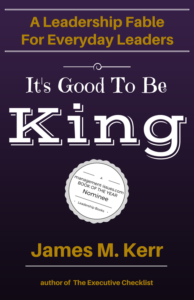Learning to Be an Exceptional Leader
Jim Kerr has just written his fifth book. You may recognize the name from his weekly column in Inc. or any of his previous books. Jim has been an executive coach and consultant for nearly 30 years. Currently, he is the global chair of Culture Transformation at the management consulting and search firm N2Growth. His latest book, It’s Good To Be King: A Leadership Fable for Everyday Leaders, is written in a fun and easy-to-access parable form that enables the reader to quickly embrace his leadership takeaways.
This lighthearted story presents sound leadership fundamentals and reinforces the notion that, regardless of the circumstances, we can all learn to become even more exceptional at leading others.
I spoke with Jim recently about his new book.
This book is much different from the others that you have written. In fact, some may even consider it a bedtime story. Why did you choose a fable format to house the leadership advice that you offer throughout the book?
There are two reasons that underpin this choice of format. First, I want the book to be consumed quickly and easily. There are far too many leadership titles available that offer dry and uninspired content, which make them difficult to get through and enjoy. Second, I want this book to be read and appreciated by all kinds of people, not just those who manage others in a business setting.
Sure, business professionals of all types – from the harried C-suite executive, who is looking for a quick “leadership read” to the Gen Y new hire who is eager to gain useful insight for career advancement – will find great value in the book. But I would like people who simply aspire to become better leaders in their everyday lives to want to read this book.
People like you and me who lead others in their communities, places of worship or volunteer organizations should pick up this book and find valuable insights that can help them become better leaders.
Exceptional Leaders Shift Styles for Results
You conclude each chapter with a running list of leadership tips and takeaways. I found this device to be a terrific way to capture the subtle messages brought out in the story.
The whole collection of tips and takeaways offered, and there are over 60 presented in the book, sort of form my personal leadership philosophy. The backbone of my leadership ideas revolves around starting with people where they are and then providing the support and guidance needed to get them to where they need to be in order for them to assist their organizations to achieve great things.
This means that sometimes a person may need a pat on the back and sometimes may need a kick in the butt. However, great leaders know when to apply each method to get results. A single speed is not enough to become an exceptional leader. Leaders need to know when to inspire, teach, coach, tell and empower. The exceptional leader seamlessly shifts their style to accommodate the situation at hand. This book attempts to illustrate those points in a simple story about a king who inherits the throne.
Without giving away too much, the tale centers on King Joe and his trusted advisor the Wizard Gumdorf. As we read the story, we see just what steps they take to transform the Kingdom to its previous glory. It’s very much a story about transformation.
Absolutely! And the Wizard plays a very pivotal role in the story. He brings with him special knowledge and wisdom, much like consultant and executive coaches do in the business world. Through his counsel, the King learns and adopts behaviors that help him to become an exceptional leader.
It’s my belief that it’s extremely lonely at the top of most organizations, and executive must have an independent third party to bounce ideas around with – someone whom they can trust and has the experience to provide sound advice. Without that, senior leaders can fall victim to some of the bad leadership styles that I also call attention to in the book.
Toxic Traits
You identify several traits of poor leaders, and you give them names and characteristics in the book. Which ones of those do you think are the most toxic for an organization?
They’ll all do some damage if left to their own devices. Don the Deceiver demonstrates that deceit was an acceptable practice and anarchy breaks out in the Kingdom. When Nancy the Narcissist is in command, she steals credit from her subordinates and cultivates a culture that demotivates people from doing their best.
So any bad behavior on the part of a leader will hurt their organization. From uncalculated risk-taking to bullying staff members, poor leadership leads to poor results. It’s really that simple.
Strategic vision is another recurring theme brought out in the book. Why the emphasis?
It’s difficult to rally the troops if the leader can’t articulate a vivid and compelling vision for what they need to achieve – one that everyone can see themselves being extremely successful in. So when the Wizard prompts the King for his vision, it’s the beginning of the transformation. Without a clear expression of his intention for the Kingdom, the King will fail to improve on the mess that he’s just inherited.
Clearly, there are parallels to be drawn between the King’s plight as told in the story and that of many executives who come into situations where they are charged to turn things around. But vision may not be enough to get the job done. Isn’t there more to leadership than vision?
Indeed, once the vision is established it’s critical that a strategic plan be developed which identifies all of the work that must be accomplished to move the organization from its current state toward the achievement of the stated vision. In fact, this is a lot of what I do with my clients. I help them to organize the work that is needed to create projects and programs which are then staffed, funded and executed to move the organization forward.
The Wizard plays that role for the King in the book.
The book concludes with the King and his advisor working to find a successor to continue on with the great changes that have begun under his leadership. They turn to the outside for the “right” person. Do you think that’s always the case? Must an organization look outside to find its next group of leaders?
 The short answer to that question is no. Organizations that cultivate great leaders have great leaders to call upon to succeed current leaders. That said, too much of that kind of succession planning limits an organization’s ability to pivot because too much of the same kind of thinking is likely to prevail from a leader promoted from within.
The short answer to that question is no. Organizations that cultivate great leaders have great leaders to call upon to succeed current leaders. That said, too much of that kind of succession planning limits an organization’s ability to pivot because too much of the same kind of thinking is likely to prevail from a leader promoted from within.
In this story, I wanted to introduce the notion that once the Kingdom was brought back on track, a new leader, with fresh perspectives and ideas, should be introduced from the outside to take the Kingdom even further.
Interestingly, all of the ideas that underpin It’s Good To Be King: A Leadership Fable for Everyday Leaders have been derived from real life business experiences that I’ve worked on within my executive coaching and consulting practice. I hope that this books helps others learn from that experience.
It’s Good To Be King: A Leadership Fable for Everyday Leaders

